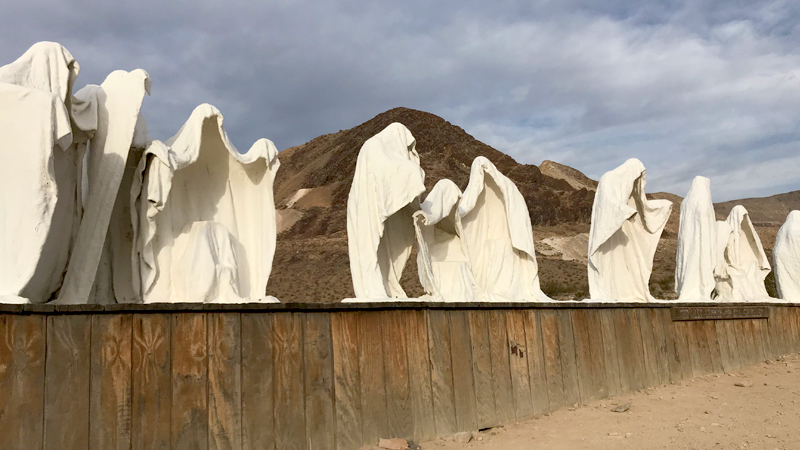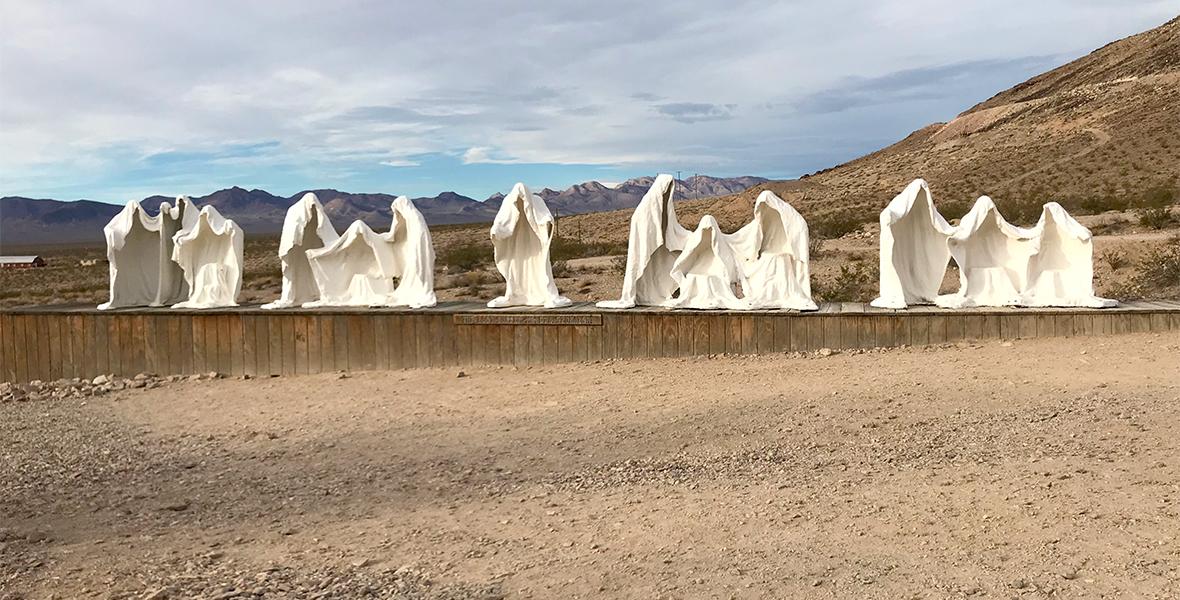
Every time we go on a road trip, I make a list of all the things I want to do and see along the way. When we planned our trip to Death Valley National Park, I did the same thing, and once again Brian was skeptical that we’d have time to do everything I wanted to — especially with it getting dark so early. But like our road trip this past summer to Crater Lake National Park and Redwood National Park, we actually ended up with a little extra time to do a few things even I didn’t think we’d have time for!
Our last day exploring Death Valley actually started outside the national park. The main activity of the day was driving the 27 mile Titus Canyon Road, the most popular back-country road in the park. It’s a one-way road that starts just outside Beatty, Nevada and ends in Death Valley, and because we were going to be in the area anyway, we left early to first visit the Rhyolite Ghost Town.
We turned off HWY 374 onto Rhyolite Road and as we drove toward the historic ghost town, we saw art installations and sculptures and what looked like ghostly figures sitting smack in the middle of the sagebrush and dry Mojave Desert. Say what?! It seemed like such a weird location to find giant sculptures, but at the same time the perfect place because they stood proudly with no distraction in the flat desert landscape of tans and browns.
While it may not look like much at first, with just one tiny old building from the 1900s in the middle of various art installations, the Goldwell Open Air Museum is worldwide a destination for artists and art lovers. But it wasn’t always a museum…

Goldwell Museum And Sculpture History
In 1984, Belgian artist Albert Szukalski came to Mojave Desert to create what many consider to be the most unique piece of his career. The Last Supper, modeled after Leonardo Da Vinci’s fresco of the Last Supper. Known for many years in Europe as the sculptor of ghosts, Szukalski molded his shapes by draping plaster-soaked burlap over live models until the plaster dried enough to stand on its own. In that same year he also create Ghost Rider, a plaster ghost figure about to ride bicycle.
Following Szukalski’s lead, three other Belgian artists also created large-scale, on-site sculptures and art installations against the backdrop of the Amargosa Valley near Death Valley.
- In 1992, Dr. Hugo Heyrman created Lady Desert: The Venus of Nevada, a 3D, 30 foot, cinder block sculpture of a naked woman that contrasts classical Greek sculpture with the technological, pixelated world of the 21 century.
- Also in 1992, Dre Peters created Icara, a hand-carved female version of Icarus, headstrong boy who flew too close to the sun with wax wings, which subsequently melted, plunging him back to earth.
- In 1994, Fred Bervoets created Tribute to Shorty Harris, a 24 foot tall, rusted metal sculpture of Shorty Harris, whose strike with partner Ernest Cross kicked off the Bullfrog mining bonanza and the establishment of the town of Rhyolite. In the sculpture, he oddly stands next to a penguin. According to the museum, the penguin is a self-portrait of the artist symbolizing his feeling of displacement in the Nevada desert, but other say it’s because Shorty often saw a penguin following him around when he was drunk.
After the death of Albert Szukalski, the nonprofit Goldwell Open Air Museum was organized. In 2006, Eames Demetrios added a plaque, Rhyolite’s District of Shadows, and in 2007, Sofie Siegmann’s couch called Sit Here!, originally created for the Lied Discovery Children’s Museum in Las Vegas, was restored and moved to the location.
Today the museum offers a spectacular south-facing view across the Mojave Desert and features several other sculptures, a labyrinth, and a couple abandoned buildings. With an artist residency program and artist workspace programs offered in the nearby Red Barn Art Center, Goldwell remains a destination for artists from across the world.
Visiting Goldwell Open Air Museum
If you’re planning on visiting the Rhyolite ghost town, plan to spend a little extra time exploring the Goldwell museum art installations. When we visited the museum, the visitor center was closed and we were the only people there. Thankfully, on the front porch of the visitor center there was a box with brochures and information about each sculpture so we could learn about the art and artists.
We explored the abandoned buildings, took turns lounging on the colorful mosaic couch, walked the labyrinth, and stopped to admire and discuss each sculpture and art installation. The white ghostly figures were our favorite and set against the stark desert, they were a bit creepy, eerie, and amazing all at the same time.
Know Before You Go
- The Goldwell Open Air Museum is a 15-acre outdoor sculpture park near the ghost town of Rhyolite, Nevada located about 115 miles northwest of Las Vegas and about 4 miles west of Beatty off State Route 374, and about 5 miles east of Death Valley National Park.
- The sculpture park is free and open to the public open 24 hours, 7 days a week.
- The visitor center with exhibits and a gift shop, is open most days from 10:00 am to 4:00 pm except Sundays, but in the summer, it usually closes by 2:00 pm because of the heat.
- Free self-guided tour brochures are available that tell you all about the different installations. If the visitor center is closed when you visit, brochures are available in a box on the porch.
- The nearest restrooms are in the Rhyolite ghost town at the very end of the road.












